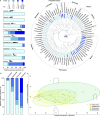Multiple evolutionary origins and losses of tooth complexity in squamates
- PMID: 34650041
- PMCID: PMC8516937
- DOI: 10.1038/s41467-021-26285-w
Multiple evolutionary origins and losses of tooth complexity in squamates
Abstract
Teeth act as tools for acquiring and processing food, thus holding a prominent role in vertebrate evolution. In mammals, dental-dietary adaptations rely on tooth complexity variations controlled by cusp number and pattern. Complexity increase through cusp addition has dominated the diversification of mammals. However, studies of Mammalia alone cannot reveal patterns of tooth complexity conserved throughout vertebrate evolution. Here, we use morphometric and phylogenetic comparative methods across fossil and extant squamates to show they also repeatedly evolved increasingly complex teeth, but with more flexibility than mammals. Since the Late Jurassic, multiple-cusped teeth evolved over 20 times independently from a single-cusped common ancestor. Squamates frequently lost cusps and evolved varied multiple-cusped morphologies at heterogeneous rates. Tooth complexity evolved in correlation with changes in plant consumption, resulting in several major increases in speciation. Complex teeth played a critical role in vertebrate evolution outside Mammalia, with squamates exemplifying a more labile system of dental-dietary evolution.
© 2021. The Author(s).
Conflict of interest statement
The authors declare no competing interests.
Figures




References
-
- Bels, V. L. et al. Biomechanics Of Feeding In Vertebrates (Springer-Verlag Berlin Heidelberg, 1994).
-
- Ungar, P. S. Mammal Teeth: Origin, Evolution, and Diversity (JHU Press, 2010).
Publication types
MeSH terms
LinkOut - more resources
Full Text Sources

